Neamen D. Microelectronics: Circuit Analysis and Design
Подождите немного. Документ загружается.


1208 Part 3 Digital Electronics
two transistors is in parallel with the previous three transistors, and this configuration
performs the basic OR function of gate
G
4
. This output signal goes through an in-
verter to become the final carry-out signal.
We can go through the same discussion for the design of the NMOS portion of
the sum-out signal. The PMOS design is then the complement of the NMOS design.
As mentioned, the total number of transistors in the final design is considerably less
than would have occurred if the basic OR and AND gates shown in the logic diagram
were actually incorporated in the design.
16.8 MEMORIES: CLASSIFICATIONS
AND ARCHITECTURES
Objective: • Discuss semiconductor memories.
In the previous sections of this chapter, various logic circuits were considered. Com-
binations of gates can be used to perform logic functions such as addition, multipli-
cation, and multiplexing. In addition to these combinatorial logic functions, digital
computers require some method of storing information. Semiconductor circuits form
Carry-out
Sum-out
G1
A
B
C
A
B
C
G3
G2
G4
Figure 16.68 Gate configuration of the one-bit full adder
Sum-out
Carry-out
C
C
C
C
BA
CBAB
BB
BA
A
A
CA
B
B
A
A
M
NA2
V
DD
V
DD
M
NA1
M
NC1
M
NB2
M
NB1
Figure 16.69 Transistor configuration of the CMOS one-bit full adder
nea80644_ch16_1145-1254.qxd 07/12/2009 3:38 Page 1208 pinnacle MHDQ-New:MHDQ134:MHDQ134-16:

Chapter 16 MOSFET Digital Circuits 1209
one type of memory, considered in this chapter, and define a class of digital elec-
tronic circuits that are just as important as the logic gates.
A memory cell is a circuit, or in some cases just a single device, that can store a
bit of information. A systematic arrangement of memory cells constitutes a memory.
The memory must also include peripheral circuits to address and write data into the
cells as well as detect data that are stored in the cells.
In this section, we define the various types of semiconductor memories, discuss
the memory organization, and briefly consider address decoders. In the next section,
we analyze in detail some of the basic memory cells and briefly discuss sense
amplifiers.
Classifications of Memories
Two basic types of semiconductor memory are considered. The first is the random
access memory (RAM), a read–write memory, in which each individual cell can be
addressed at any particular time. The access time to each cell is virtually the same.
Implicit in the definition of the RAM is that both the read and write operations are
permissible in each cell with also approximately the same access time. Both static
and dynamic RAM cells are considered.
A second class of semiconductor memory is the read-only memory (ROM).
The set of data in this type of memory is generally considered to be fixed, although
in some designs the data can be altered. However, the time required to write new data
is considerably longer than the read access time of the memory cell. A ROM may be
used, for example, to store the instructions of a system operating program.
A volatile memory is one that loses its data when power is removed from the cir-
cuit, while nonvolatile memory retains its data even when power is removed. In gen-
eral, a random access memory is a volatile memory, while read-only memories are
nonvolatile.
Random Access Memories
Two types of RAM are the static RAM (SRAM) and dynamic RAM (DRAM). A sta-
tic RAM consists of a basic bistable flip-flop circuit that needs only a dc current or
voltage applied to retain its memory. Two stable states exist, defined as logic 1 and
logic 0. A dynamic RAM is an MOS memory that stores one bit of information as
charge on a capacitor. Since the charge on the capacitor decays with a finite time con-
stant (milliseconds), a periodic refresh is needed to restore the charge so that the
dynamic RAM does not lose its memory.
The advantage of the SRAM is that this circuit does not need the additional com-
plexity of a refresh cycle and refresh circuitry, but the disadvantage is that this circuit
is fairly large. In general, SRAM requires six transistors. The advantage of a DRAM
is that it consists of only one transistor and one capacitor, but the disadvantage is the
required refresh circuitry and refresh cycles.
Read-Only Memories
There are two general types of ROM. The first is programmed either by the manu-
facturer (mask programmable) or by the user (programmable, or PROM). Once the
ROM has been programmed by either method, the data in the memory are fixed and
cannot be altered. The second type of ROM may be referred to as an alterable ROM
in that the data in the ROM may be reprogrammed if desired. This type of ROM may
16.8.1
nea80644_ch16_1145-1254.qxd 07/12/2009 3:38 Page 1209 pinnacle MHDQ-New:MHDQ134:MHDQ134-16:
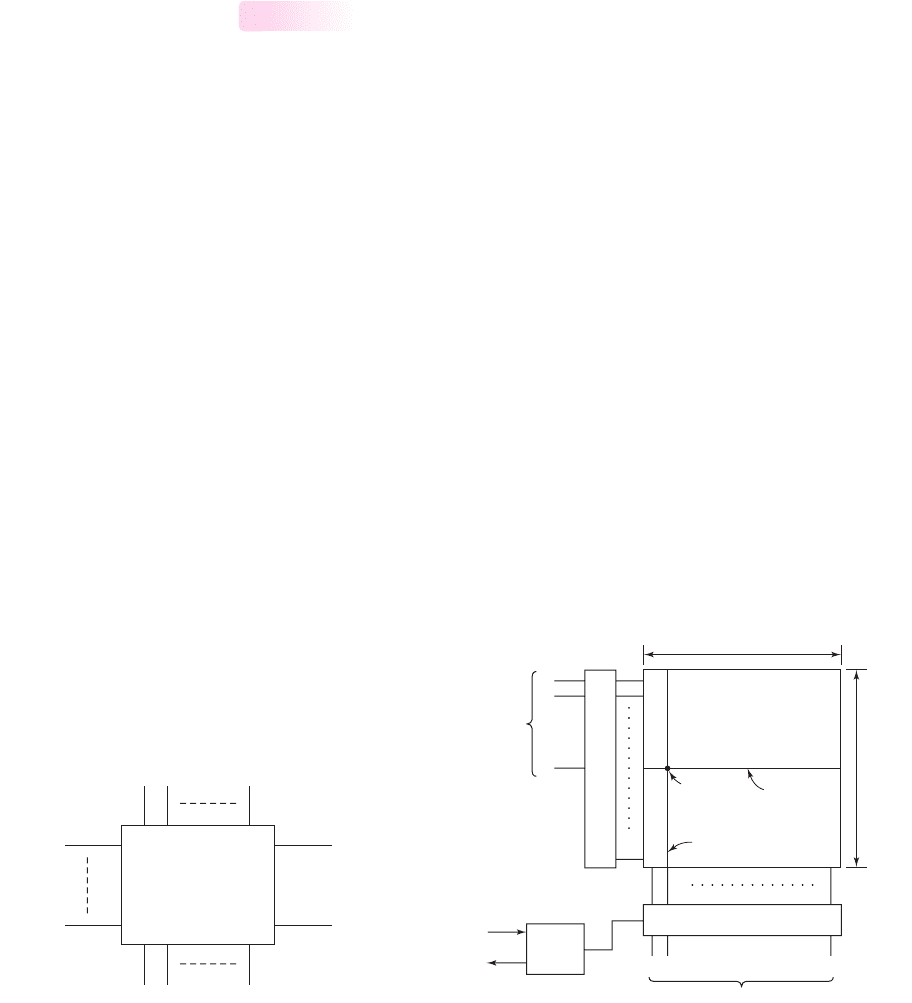
1210 Part 3 Digital Electronics
be called an EPROM (erasable programmable ROM), EEPROM (electrically
erasable PROM), or flash memory. As mentioned, the data in these memories can be
reprogrammed although the time involved is much longer than the read access time.
In some cases, the memory chip may actually have to be removed from the circuit
during the reprogramming process.
Memory Architecture
The basic memory architecture has the configuration shown in Figure 16.70. The ter-
minal connections may include inputs, outputs, addresses, and read and write con-
trols. The main portion of the memory involves the data storage. A RAM memory
will have all of the terminal connections mentioned, whereas a ROM memory will
not have the inputs and the write controls.
A typical RAM architecture, shown in Figure 16.71, consists of a matrix of stor-
age bits arranged in an array with
2
M
columns and
2
N
rows. The array may be square,
in which case M and N are equal. This particular array may be only one of several on
a single chip. To read data stored in a particular cell within the array, a row address is
inputted and decoded to select one of the row lines. All of the cells along this row are
activated. A column address is also inputted and decoded to select one of the
columns. The one particular memory cell at the intersection of the row and column
addressed is then selected. The logic level stored in the cell is routed down a bit line
to a sense amplifier.
Control circuits are used to enable or select a particular memory array on a chip
and also to select whether data are to be read from or written into the memory cell.
Memory chips or arrays are designed to be paralleled so that the memory capacity
can be increased. The additional lines needed to address parallel arrays are called
chip select signals. If a particular chip or array is not selected, then no memory cell
is addressed in that particular array. The chip select signal controls the tristate output
of the data-in and data-out buffers. In this way, the data-in and data-out lines to and
from several arrays may be connected together without interfering with each other.
16.8.2
Data
storage
Outputs
Inputs
Read
Write
Addresses
Figure 16.70 Schematic of a basic memory configuration
Memory
array
One cell One row
One column
Column decoder
Column address
1
12 2
M
2
N
2
N
rows
2
M
columns
2 M
Read/
write
Data
in
Data
out
Row
address
1
1
2
N
2
Row decoder
Figure 16.71 Basic random access memory architecture
nea80644_ch16_1145-1254.qxd 07/12/2009 3:38 Page 1210 pinnacle MHDQ-New:MHDQ134:MHDQ134-16:

Chapter 16 MOSFET Digital Circuits 1211
Address Decoders
The row and column decoders in Figure 16.71 are essential elements in all memories.
Access time and power consumption of memories may be largely determined by the
decoder design. Figure 16.72 shows a simple decoder with a two-bit input. The
decoder uses NAND logic circuits, although the same type of decoder may be
implemented in NOR gates. The input word goes through input buffers that generate
the complement as well as the signal.
16.8.3
–
a
0
a
1
a
0
a
0
–
X
0
–
X
1
–
X
2
–
X
3
–
a
1
a
1
Figure 16.72 Simplified decoder with two-bit input
V
DD
V
DD
a
4
a
3
–
a
2
–
a
1
a
0
–
a
i
a
i
a
i
X
5
(a) (b)
Figure 16.73 (a) Input buffer-inverter pair; (b) five-input NOR logic address decoder
Another example of the direct implementation of a decoder is shown in
Figure 16.73. Figure 16.73(a) shows a pair of NMOS input buffer-inverters, and
Figure 16.73(b) shows a five-input NOR logic address decoder circuit using NMOS
enhancement-mode drivers and a depletion load. A pair of input-buffer inverters is
required for each input address line. The input signal is then required to drive only an
inverter, while the buffer-inverter pair can be designed to drive the remainder of the
logic circuits. The output of the NOR decoder goes high only when all inputs are a
logic 0. The NOR gate in Figure 16.73(b) would decode the address word 00110 and
select the seventh row or column for a read or write operation. (Note: An input of
00000 is used to address the first row or column.)
As the size of the memory increases, the length of the address word must
increase. For example, a 64-K (where
1K= 1024 bits
) memory whose cells are
nea80644_ch16_1145-1254.qxd 07/12/2009 3:38 Page 1211 pinnacle MHDQ-New:MHDQ134:MHDQ134-16:
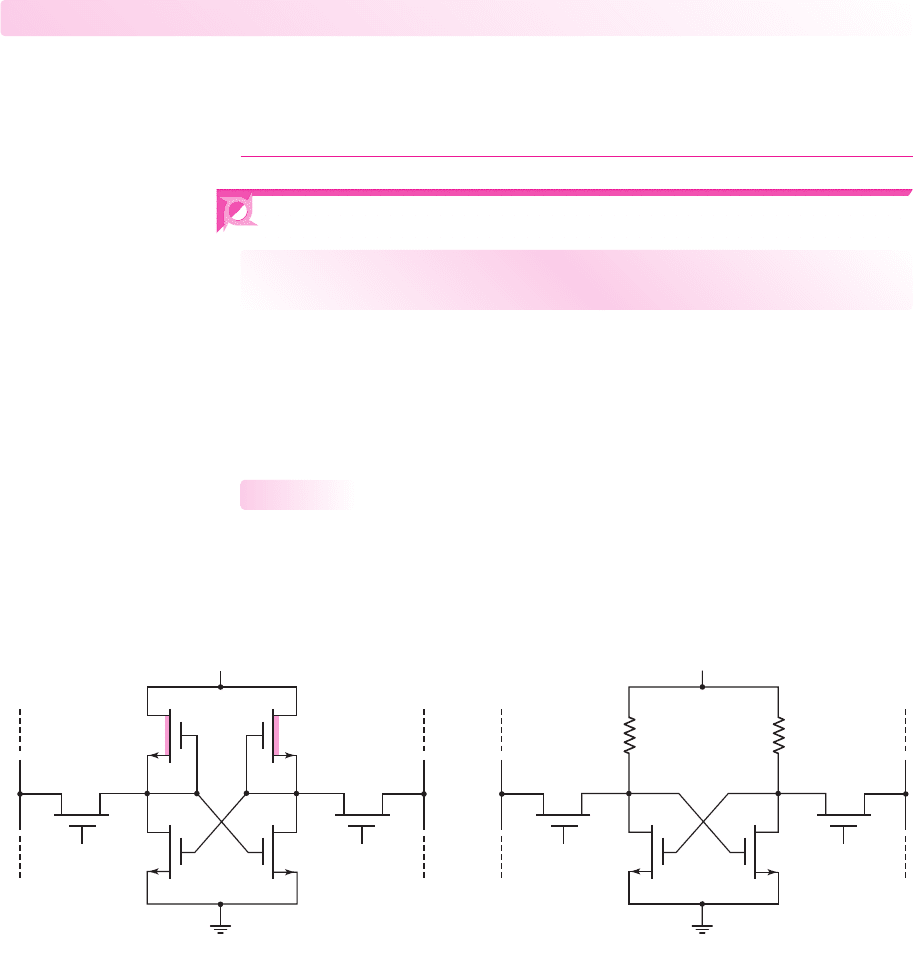
1212 Part 3 Digital Electronics
arranged in a square array would require an 8-bit word for the row address and
another 8-bit word for the column address. As the word size increases, the decoder
becomes more complex, and the number of transistors and power dissipation may
become large. In addition, the total capacitance of MOS decoder transistors and
interconnect lines increase so that propagation delay times may become significant.
The number of transistors required to design a decoder may be reduced by using a
two-stage decoder using both NOR and NAND gates. These circuits may be found in
more advanced textbooks on digital circuits.
Test Your Understanding
TYU 16.15 A NOR logic address decoder, such as shown in Figure 16.73(b), is used
in both the row and column address decoders in a memory arranged in a square array.
Calculate the number of decoder transistors required for a (a) 1-K, (b) 4-K, and
(c) 16-K memory. (Ans. 384, 896, 2048 plus buffer transistors.)
16.9 RAM MEMORY CELLS
Objective: • Analyze and design random-access-memory (RAM) cells
In this section, we consider two designs of an NMOS static RAM (SRAM), one
design of a CMOS static RAM, and one design of a dynamic RAM (DRAM). We
also consider examples of sense amplifiers and read/write circuitry. This section is
intended to present the basic concepts used in memory cell design. More advanced
designs can again be found in advanced texts on digital circuits.
NMOS SRAM Cells
A static RAM cell is designed by cross-coupling the inputs and outputs of two
inverters. In the case of an NMOS design, the load devices may be either depletion-
mode transistors or polysilicon resistors, as shown in Figure 16.74. In either case, the
16.9.1
X
Row
select
X
Row
select
X
Row
select
M
1
M
2
Q
RR
Q
X
Row
select
–
M
1
M
2
M
3
M
A
V
DD
V
DD
M
B
M
A
M
B
M
4
QQ
–
D
–
D
–
D
D
(a) (b)
Figure 16.74 Static NMOS RAM cells with (a) depletion loads and (b) polysilicon resistor loads
nea80644_ch16_1145-1254.qxd 07/12/2009 3:38 Page 1212 pinnacle MHDQ-New:MHDQ134:MHDQ134-16:

Chapter 16 MOSFET Digital Circuits 1213
inputs and outputs of the two inverters are cross-coupled to form a basic flip-flop. If
transistor
M
1
is turned on, for example, the output Q is low, which means that tran-
sistor
M
2
is cut off. Since
M
2
is cut off, the output
¯
Q
is high, ensuring that
M
1
is
turned on. Thus, we have a static situation as long as the bias voltage
V
DD
is applied
to the circuit.
To access (read or write) the data contained in the memory cell, two NMOS
transmission gate transistors,
M
A
and
M
B
, connect the memory cell to the comple-
mentary bit lines. When the word line signal or row select signal is low, both trans-
mission gate transistors are cut off and the memory cell is isolated or in a standby
condition. The data stored in the cell remain stored as long as power is applied to the
cell. When the row select or word line signal goes high, the memory cell is then con-
nected to the complementary data lines so that the data in the cell can be read or new
data can be written into the cell.
One critical parameter in the design of RAM cells is power dissipation. As we
will see in the following example, this is one situation in which incorporating a high-
valued resistor as a load device improves the design. A lightly doped polysilicon load
resistor is formed by ion implantation, which can accurately dope the polysilicon to
produce the designed resistance value.
EXAMPLE 16.14
Objective: Determine the currents, voltages, and power dissipation in two NMOS
SRAM cells. The first design uses a depletion-load device and the second design uses
a resistor-load device.
Assume the following parameters:
V
DD
= 3V
and
k
n
= 60 μA/V
2
; driver
transistors:
V
TND
= 0.5V
and
(W/L)
D
= 2
; load devices:
V
TNL
=−1.0V
,
(W/L)
L
= 1/2
, and
R = 2M
.
Solution (With Depletion Load): Assume
M
2
is cut off in the circuit in Figure 16.74(a)
so that
¯
Q = V
DD
= 3V
.
M
1
is on in the nonsaturation region and
M
3
is on in the
saturation region. The drain current in
M
1
and
M
3
is then
i
D
=
k
n
2
·
W
L
L
(
V
GSL
− V
TNL
)
2
=
60
2
·
1
2
(
0 −
(
−1
))
2
or
i
D
= 15 μA
The power dissipated in the circuit is then
P = i
D
· V
DD
= (15)(3) = 45 μW
The logic 0 value of the Q output is found from
i
D
=
k
n
2
·
W
L
D
2
(
V
GSD
− V
TND
)
V
DSD
− V
2
DSD
or
15 =
60
2
· (2)[2(3 − 0.5)Q − Q
2
]
which yields
Q = 50.5mV
nea80644_ch16_1145-1254.qxd 07/12/2009 3:38 Page 1213 pinnacle MHDQ-New:MHDQ134:MHDQ134-16:

1214 Part 3 Digital Electronics
Solution (With Resistor Load): Again assume
M
2
is cut off in the circuit in
Figure 16.74(b) so that
¯
Q = V
DD
= 3V
. Again
M
1
is on in the nonsaturation
region. The drain current is found from
V
DD
− Q
R
=
k
n
2
·
W
L
D
[2
(
V
GSD
− V
TND
)
Q − Q
2
]
or
3 − Q
2
=
60
2
· (2)[2(3 − 0.5)Q − Q
2
]
[Note that dividing by megohms on the left agrees with microamperes on the right.]
We find
Q
∼
=
5mV
The drain current is then found:
i
D
=
V
DD
− Q
R
=
3 − 0.005
2
∼
=
1.5 μA
The power dissipated in the circuit is then
P = i
D
· V
DD
= (1.5)(3) = 4.5 μW
Comment: We see that the SRAM with the resistive load dissipates 10 times less
power than the SRAM with the depletion-load device. Thus, for a given allowed
power dissipation per chip, the memory with the resistive load could be 10 times
larger than that using the depletion load device.
EXERCISE PROBLEM
Ex 16.14: A 16-K NMOS static RAM cell using a resistor load is to be designed.
Each cell is to be biased at
V
DD
= 2.5V
. Assume transistor parameters as de-
scribed in Example 16.14. The entire memory is to dissipate no more than
125 mW in standby. Design the value of R in each cell to meet this specification.
(Ans.
R = 0.82 M
)
Since the value of the load resistance R is, in general, very large, the memory must
be designed so that the resistor R is not required to be a pull-up device. We will see
this type of design later. The resistors can actually be fabricated on top of the NMOS
transistors by a double-polysilicon technology, so that the cell with resistor load de-
vices can be very compact, resulting in a high-density memory.
CMOS SRAM Cells
The basic six-transistor CMOS SRAM cell is shown in Figure 16.75. The inputs and
outputs of the two CMOS inverters are cross-coupled so that the circuit will be in one
of two static conditions. For example, if
¯
Q
is low, then
M
N1
is cut off so that Q is
high, which in turn means that
M
P2
is cut off, ensuring that
¯
Q
remains low. The two
NMOS transmission gate transistors again connect the basic memory cell to the
complementary data lines.
16.9.2
nea80644_ch16_1145-1254.qxd 07/12/2009 3:38 Page 1214 pinnacle MHDQ-New:MHDQ134:MHDQ134-16:
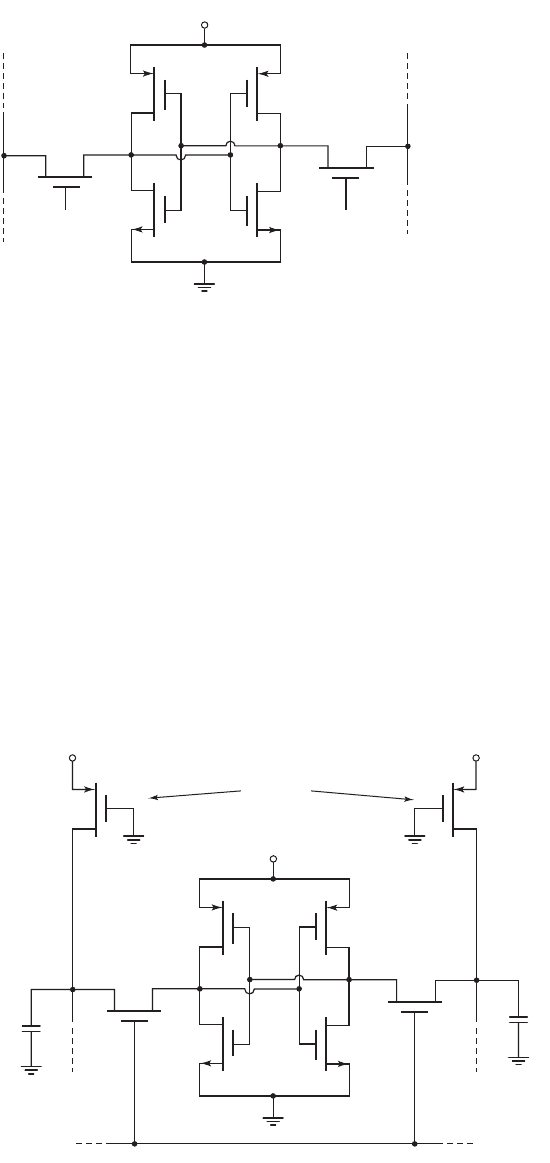
Chapter 16 MOSFET Digital Circuits 1215
The traditional advantages of CMOS technology include low static power dissi-
pation, superior noise immunity to either bipolar or NMOS, wide operating temper-
ature range, sharp transfer characteristics, and wide voltage supply tolerance.
CMOS is inherently lower power than NMOS, since conducting paths between
power and ground do not arise when the circuit is in one logic state or the other. In
standard CMOS, the p- and n-channel devices in the memory cell and in the periphery
circuits are in series and on at the same time only during switching. Current is, there-
fore, drawn only during switching. This makes SRAMs and CMOS extremely low
power in standby, when there are only surface, junction, and channel leakage currents.
A more complete circuit of the CMOS static RAM is shown in Figure 16.76,
which includes PMOS data line pull-up transistors on the complementary bit lines. If
all word line signals are zero, then all pass transistors are turned off. The two data
lines with the relatively large column capacitances are charged up by the column
pull-up transistors,
M
P3
and
M
P4
, to the full
V
DD
voltage.
–
–
D
D
M
P1
M
A
M
B
M
P2
M
N1
M
N2
Q
Q
V
DD
X
Row
select
X
Row
select
Figure 16.75 A CMOS static RAM cell
Word line
Pull-up
transistors
–
–
–
M
P4
M
P3
DD
M
P1
M
A
M
B
M
P2
M
N1
M
N2
Q
Q
V
DD
C
D
C
D
V
DD
V
DD
Figure 16.76 CMOS RAM cell including PMOS pull-up transistors
nea80644_ch16_1145-1254.qxd 07/12/2009 3:38 Page 1215 pinnacle MHDQ-New:MHDQ134:MHDQ134-16:
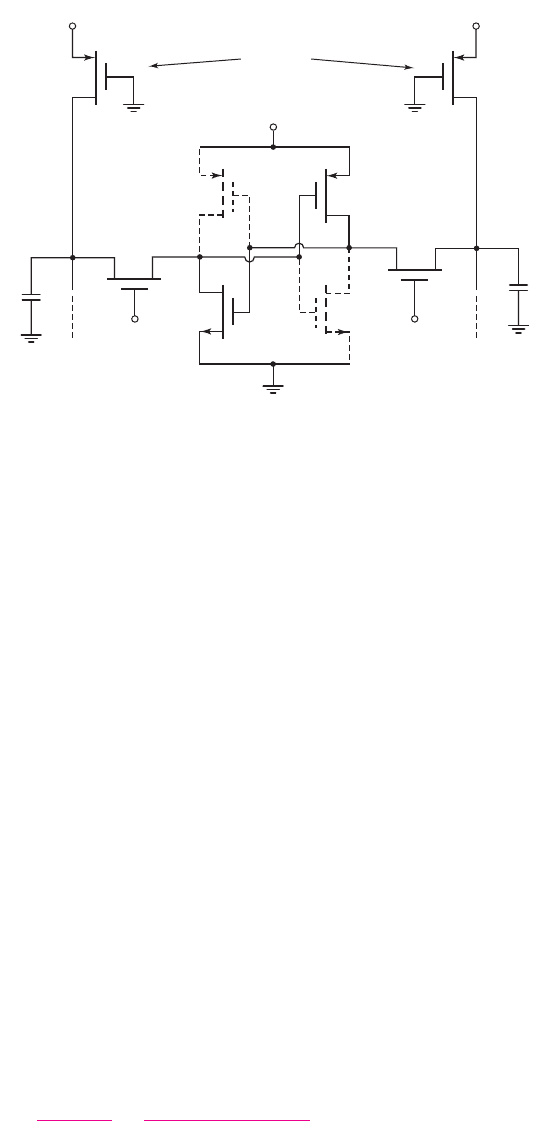
1216 Part 3 Digital Electronics
To determine the
(W/L)
ratios of the transistors in a typical CMOS SRAM cell,
two basic requirements must be taken into consideration. First, the read operation
should not destroy the information stored in the cell, and second, the cell should
allow for the modification of the data stored during a write operation. Consider a read
operation in which a logic 0 (
Q = 0
and
¯
Q = V
DD
) is stored in the cell. The voltage
levels in the cell and on the data lines just prior to the read operation are shown in
Figure 16.77. Transistors
M
P1
and
M
N2
are turned off while transistors
M
N1
and
M
P2
are biased in the nonsaturation region.
Immediately after the word select signal is applied to the pass transistors
M
A
and
M
B
, the voltage on the
¯
D
data line will not change significantly, since the pass tran-
sistor
M
B
is actually not conducting and no current flows. On the opposite side of the
cell, current will flow through
M
A
and
M
N1
so that the voltage on the D data line will
drop and the voltage Q will increase above its initial zero value. The key design point
is that Q must not become larger than the threshold voltage of
M
N2
, so that
M
N2
re-
mains cut off during the read phase. This will ensure that there is not a change in the
data stored in the cell.
At the initial time the cell is addressed, we can assume that the D bit line remains
at approximately
V
DD
, since the line capacitance cannot change instantaneously. The
pass transistor
M
A
is biased in the saturation region and the transistor
M
N1
is biased
in the nonsaturation region. Setting the drain currents through
M
A
and
M
N1
equal,
we have
K
nA
(V
DD
− Q − V
TN
)
2
= K
n1
[2(V
DD
− V
TN
)Q − Q
2
]
(16.81)
Setting
Q = Q
max
= V
TN
as our design limit, then from Equation (16.81), we find
the relation between the transistor width-to-length ratios to be
(W/L)
nA
(W/L)
n1
<
2(V
DD
V
TN
) − 3V
2
TN
(V
DD
−2V
TN
)
2
(16.82)
Assuming that
V
DD
= 3V
and
V
TN
= 0.5V
, we find that
(W/L)
nA
/(W/L)
n1
< 0.56
.
So the width-to-length of the pass transistor should be approximately one-half that of
Pull-up
transistors
–
–
–
M
P4
M
P3
DD
M
P1
M
A
M
B
M
P2
M
N1
M
N2
Q = V
DD
Q = 0 V
V
DD
V
DD
V
DD
V
DD
V
DD
C
D
C
D
V
DD
V
DD
Figure 16.77 Voltage levels and “on” transistors in CMOS RAM cell at the beginning of the
read cycle
nea80644_ch16_1145-1254.qxd 07/12/2009 3:38 Page 1216 pinnacle MHDQ-New:MHDQ134:MHDQ134-16:
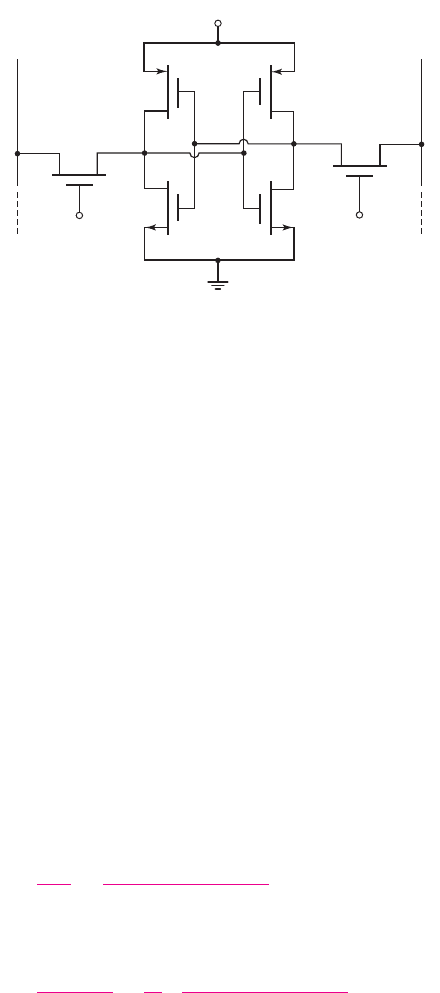
Chapter 16 MOSFET Digital Circuits 1217
the NMOS device in the memory cell. By symmetry, the same condition applies to
the transistors
M
N2
and
M
B
.
We now need to consider the write operation. Assume that a logic 0 is stored and
we want to write a logic 1 into the memory cell. Figure 16.78 shows the initial volt-
age levels in the CMOS SRAM cell when the cell is first addressed at the beginning
of the write cycle. Transistors
M
P1
and
M
N2
are initially turned off, and
M
N1
and
M
P2
are biased in the nonsaturation region. The cell voltages are
Q = 0
and
¯
Q = V
DD
just before the pass transistors are turned on. The data line D is held at
V
DD
and the complementary data line
¯
D
is forced to a logic 0 value by the write cir-
cuitry. We may assume that
¯
D = 0V
for analysis purposes. The voltage Q will
remain below the threshold voltage of
M
N2
because of the condition given by Equa-
tion (16.82). Consequently, the voltage at Q is not sufficient to switch the state of the
memory cell. To switch the state of the cell, the voltage at
¯
Q
must be reduced below
the threshold voltage of
M
N1
, so that
M
N1
will turn off. When
¯
Q = V
TN
, then
M
B
is
biased in the nonsaturation region and
M
P2
is biased in the saturation region. Equat-
ing drain currents, we have
K
p2
(V
DD
+ V
TP
)
2
= K
nB
2(V
DD
− V
TN
)V
TN
− V
2
TN
(16.83(a))
which can be written in the form
K
p2
K
nB
<
2(V
DD
V
TN
) − 3V
2
TN
(V
DD
+ V
TP
)
2
(16.83(b))
Considering the width-to-length ratios, we find
(W/L)
p2
(W/L)
nB
<
k
n
k
p
·
2(V
DD
V
TN
) − 3V
2
TN
(V
DD
+ V
TP
)
2
(16.84)
Assuming that
V
DD
= 3V
,
V
TN
= 0.5V
,
V
TP
=−0.5V
, and
(k
n
/k
p
) =
(μ
n
/μ
p
) = 2
, we find that
(W/L)
p2
/(W/L)
nB
< 0.72
.
From previous results, if we assume that the width-to-length of the pass transis-
tor is one-half that of the NMOS in the memory cell, and if we assume that the width-
to-length of the PMOS in the memory cell is 0.7 that of the pass transistor, then the
width-to-length of the PMOS in the cell should be approximately 0.35 that of the NMOS
in the memory cell.
D
–
D
M
A
M
B
M
P2
M
P1
M
N2
M
N1
–
Q = V
DD
V
DD
V
DD
V
DD
V
DD
Q = 0
0
Figure 16.78 Voltage levels in the CMOS RAM at the beginning of a write cycle
nea80644_ch16_1145-1254.qxd 07/12/2009 3:38 Page 1217 pinnacle MHDQ-New:MHDQ134:MHDQ134-16:
